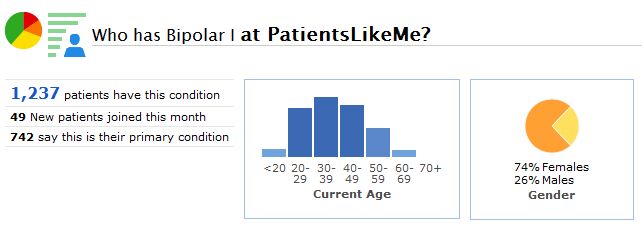Yesterday, our interview with bipolar blogger Andrea gave you a glimpse into what it’s like to live with bipolar I disorder. Today we take a deeper look into this mental health condition using the data and experiences shared by our 1,237 bipolar I members.
First off, however, you may have heard of something called bipolar II as well, so let’s talk about how bipolar I and II differ. Bipolar I is a subdiagnosis of bipolar disorder that conforms to the classic concept of manic-depressive illness. It is characterized by at least one manic or mixed episode, and there may be episodes of hypomania (marked by elevated mood, hyperactivity and grandiosity) and major depression as well. In contrast, bipolar II disorder – which is slightly more prevalent at PatientsLikeMe with 1,556 patients reporting it – is marked by depressive episodes that are more frequent and more intense than the manic episodes.
Now, let’s take a look at the wealth of data found at PatientsLikeMe. To give you a sense of the makeup of our bipolar I patients, 74% are female, more than 78% have an official bipolar I diagnosis, and approximately 40% report experiencing their first symptom prior to the age of 19. What exactly are the symptoms of this condition? Some of the most commonly reported include delusions, excitability, flight of ideas, grandiose thinking, hallucinations, irritability and paranoia. As you can see, most of these speak to the “manic” side of bipolar I disorder, which involves “excitement of psychotic proportions” as well as hyperactive, disorganized behavior.
As Andrea’s interview yesterday revealed, treating bipolar I disorder can mean treating both mania and depression simultaneously. Further, our patient-reported data shows that the two prescription medications she takes currently – lithium for mania and Lamictal for depression – are among the most commonly prescribed treatments for bipolar I patients, along with individual therapy and Seroquel. How well do these treatments work? Click on each treatment name to read our patients’ evaluations of their effectiveness, side effects, cost and more.
Finally, much can also be learned directly from the experiences our patients share on their profiles, treatment evaluations or forum posts. We leave you with several patient quotes from our Mental Health and Behavior Forum that help to fully illuminate life with bipolar I disorder:
- “My manias last for about three to four months and are followed by depressions that tend to also last three to four months. Mine is the classic form of the disease with manias characterized by hallucinations, grandiosity, and impulsivity, and depressions characterized by fatigue, guilt, and somatic concerns.”
- “The condition is every part of me as anything else. My choice to treat it arises from the consequences of living with bipolar in a non-bipolar world and not because I am broken and in need of repair. Bipolar “disorder”, well, whose order am I in disarray?”
- “Now I’m a little manic. I know what you mean about relentless depressions. I have those too. At the other end of the spectrum, I become psychotic. That’s the part that really frightens me and usually lands me in the hospital, or worse.”
- “A month ago, I truly would have been leveled by all this drama. I’ve come quite a distance in a short period of time. You guys give me such strength. I know that with your help, I can make it through life’s ups and downs while keeping mine under control.”
If you’ve got something to share about bipolar I as well, join the conversation today!

